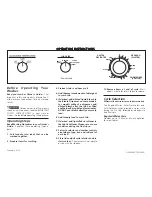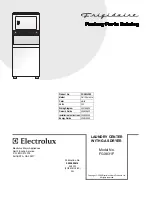
35
12-
If the hand on the vacuum gauge does not reach red (and/or the red light does not switch on), you need to check the chamber
gaskets of the vacuum (clean the gaskets or replace them) and try again.
Bag insertion test:
11-
Lift the cover.
12-
Position the open end of the empty bag in the chamber of the vacuum, between the gaskets in the vacuum chamber. (image
1)
13-
Lower the cover, press the start button (1.) and exert light pressure on the cover to start the automatic cycle.
14-
If the hand on the vacuum gauge reaches red (and/or the red led switches on) and sealing automatically starts, machine
operation is correct.
15-
If the hand on the vacuum gauge reaches red (and/or the red led switches on) but sealing does not automatically start, you
need to set the machine for automatic operation and try again.
Using these tests, you can check machine operation and you get correct insertion of the bag in the vacuum chamber.
Correct packaging is only obtained if enough free space is left between the product and the machine (approx. 5 cm. are usually enough)
provided the bag can be inserted well laid between the gaskets of the vacuum chamber, without creating folds that could create air
leaks, reducing the vacuum level and the quality of sealing.
The machine does not start:
3-
Check you have correctly inserted the plug in the electricity socket and the press is powered.
The bag is not well sealed/air is entering the bag:
21-
During the winter period, and in the presence of extreme temperature changes, the sealing bar can fill with humidity. On first
start-up of the cold machine you should execute a completed vacuum/sealing cycle with the cover closed (also without a bag) to reset
the machine and stabilise the temperature and humidity conditions. To avoid problems also on first use, the appliance
must be kept in
a dry place at a temperature of b10° and + 30°
.
22-
The bags are composed of an outer layer in nylon to protect against air intake; the nylon tends to absorb humidity especially in
the presence of temperature changes; the humidity absorbed prevents correct sealing: to solve the problem, the bags must be kept
in a
dry place at at temperature b10° and + 30°.
23-
The humidity absorbed by the outer layer of the bag can be eliminated by sealing the bag twice.
24-
Check you have left sufficient free space between the product to pack and the opening of the bag; a limited space creates
folds and bends to prevent correct sealing and limits the vacuum level reachable.
25-
Check you have cleaned the opening of the bag near the sealing point; any impurities deriving from passage of the product to
package, prevents correct sealing.
26-
Check you have removed all possible roughness that could perforate the bag; the machines create a high vacuum level with
resulting adhesion of the bag to the product, any point or roughness can create micro-pores in the bag to let air in.
27-
Humid products can cause liquid to rise towards the opening of the bag, damaging sealing; check you have dried the products
to package or use a double bag; insert the product in a first bag, fold the mould of the bag a few times (image 8) and place it in a second
bag with the opening folded of the first turned towards the bottom of the second (Images 9 and 10). You can execute the vacuum
function and any residual liquids will stay in the first bag without passing into the second, as such obtaining efficient sealing. (image 11)
28-
When you use rolls, the first sealing must be carried out by positioning the mouth on the roll (image 2) on the sealing bar and
not in the vacuum chamber; the machine seals correctly only if the cover exerts correct pressure on the sealing bar. Anticipating sealing
before having a sufficient vacuum level can create channels with air passage and make sealing inefficient. You are advised to carry out
a complete automatic vacuum/sealing cycle.
29-
Sealing only function: position the opening of the bag (image 2) on the sealing bar and not in the vacuum chamber; the
machine seals correctly only if the cover exerts correct pressure on the sealing bar. Anticipating sealing before having a sufficient
vacuum level can create channels with air passage and make sealing inefficient. You are advised to carry out a complete automatic
vacuum/sealing cycle.
30-
If air enters the bag during the sealing phase and after a correct vacuum/sealing cycle, you need to replace the bag which is
probably damaged.
The machine does not create a vacuum in the bag:
11-
Check you have correctly positioned the opening of the bag between the seals of the vacuum chamber. (image 1)
12-
Proceed with auto-diagnosis tests to ensure the machine is working correctly.
13-
The machine works correctly with Reber branded, embossed type bags. Different bags may not work adequately; check you
have used the correct bags.
14-
During the summer period (when temperatures are higher) or in the event of prolonged use, the residual heat on the sealing
bar can create pre-sealing of the bag to prevent the machine from correctly sucking: decrease the sealing power using the electronic
programming to decrease the sealing time, wait a few minutes for the sealing bar to cool and continue to work with a lower sealing
power.
15-
Check the seals on the vacuum chamber; in the event of slight liquid suction the seals can harden and get damaged; in this
case you need to change the seals.
The machine does not automatically seal:
9-
Proceed with auto-diagnosis tests to ensure the machine is working correctly.
10-
Start a vacuum cycle and manually seal to check the sealing bar is working properly.
11-
Check the electronic settings as described in the paragraph "Reset the factory parameters" or adjust the setting on automatic
operation as described in the paragraph "Pass from manual to automatic operation".
12-
Check you have left sufficient free space between the product to pack and the opening of the bag; a limited space creates
folds and bends on the opening of the bag that limits the vacuum level reachable and prevent the vacuum sensor from starting
automatic sealing.
The machine does not reach a convenient vacuum level:
13-
Check you have correctly positioned the opening of the bag between the seals of the vacuum chamber. (image 1)
14-
Proceed with auto-diagnosis tests to ensure the machine is working correctly.
15-
The machine works correctly with Reber branded, embossed type bags. Different bags may not work adequately; check you
have used the correct bags.
Summary of Contents for 9340 N
Page 2: ...2 FAMILY 9700 N 9700 NF 9701 N 9701 NF...
Page 4: ...4 IMMAGINI DI FUNZIONAMENTO Immagine 1 Immagine 2 Immagine 6 Immagine 7...
Page 47: ......
Page 48: ...GARANZIA...
















































